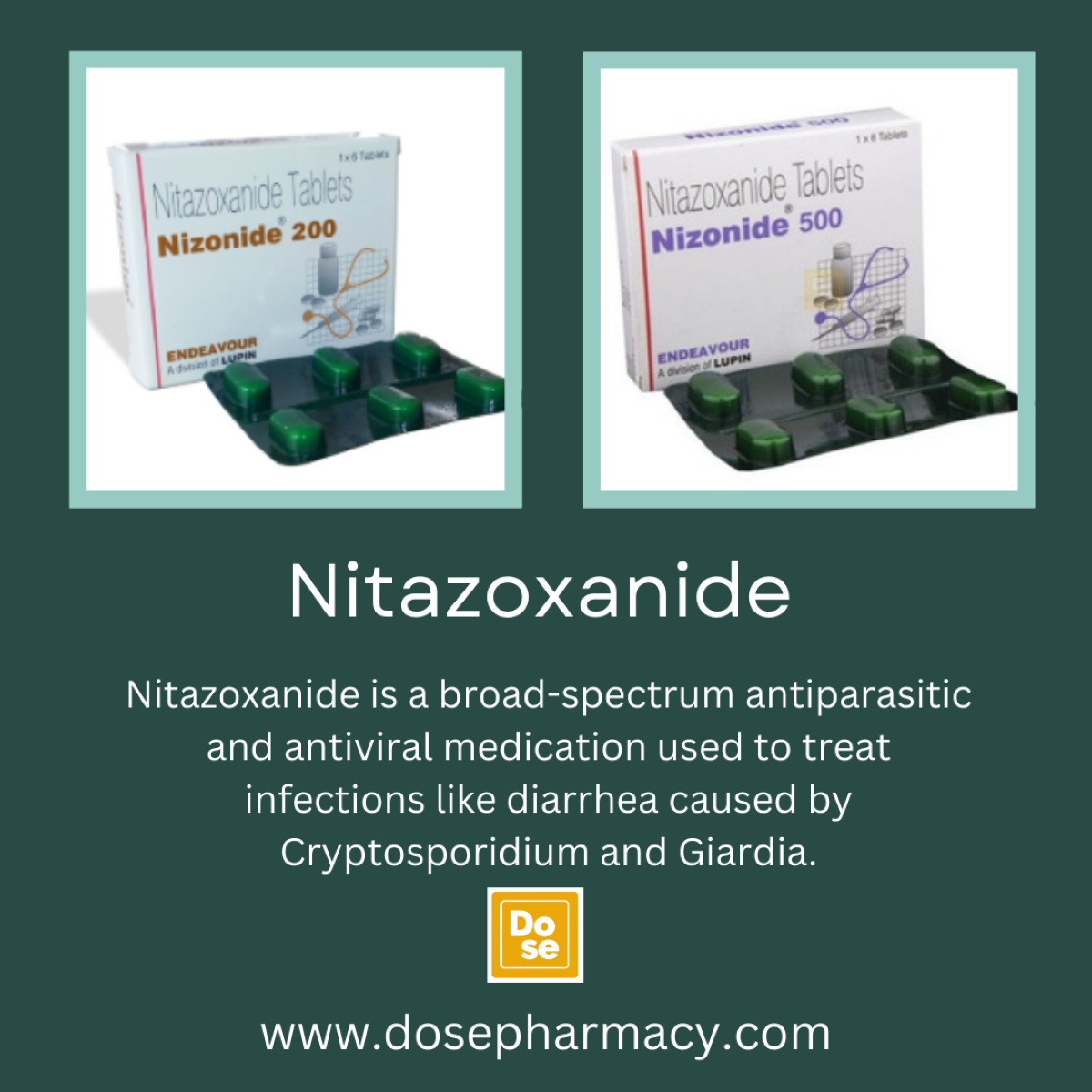What is the Recommended Dosage for Nitazoxanide?

Nitazoxanide 500 mg is an antiparasitic and antiviral medication that has been widely used to treat certain gastrointestinal infections, particularly cryptosporidiosis and giardiasis. It works by interfering with the energy metabolism of parasites and some viruses, ultimately stopping their growth and replication. The dosage of nitazoxanide depends on various factors, including age, body weight, infection type, and overall health. Understanding the correct dosage is important for effective treatment and to minimize potential side effects.
Standard Dosage Guidelines
The U.S. Food and Drug Administration (FDA) has approved Nitazoxanide 200 mg primarily for treating diarrhea caused by Giardia lamblia and Cryptosporidium parvum. The standard dosages are as follows:
Adults and Adolescents (12 years and older)
- Recommended Dose: 500 mg every 12 hours (twice daily)
- Duration: 3 days
- Form: Usually given as tablets with food
Children 4–11 years old
- Recommended Dose: 200 mg every 12 hours (twice daily)
- Duration: 3 days
- Form: Oral suspension (liquid form) with food
Children 1–3 years old
- Recommended Dose: 100 mg every 12 hours (twice daily)
- Duration: 3 days
- Form: Oral suspension with food
Special Considerations for Dosage
- Take with Food
Nitazoxanide should be taken with meals to improve absorption and effectiveness. Taking it on an empty stomach may reduce its potency. - Renal and Liver Function
In patients with kidney or liver problems, dosage adjustments may be necessary. While there are no strict dosing guidelines for such cases, a healthcare provider will determine whether to modify treatment. - Other Conditions
Nitazoxanide has been studied for off-label uses, including certain viral infections (e.g., rotavirus, hepatitis B, hepatitis C, and influenza). The dosage in these situations may differ based on the type of infection and clinical research protocols.
Why the Dosage Varies by Age
Children require smaller doses because their bodies metabolize and process medications differently than adults. Dosage adjustments ensure safety and prevent overdose. The liquid form makes it easier for younger children to take the medication and ensures accurate dosing.
Missed Dose Instructions
If a dose is missed:
- Take it as soon as you remember.
- If it’s almost time for the next dose, skip the missed dose and continue the regular schedule.
- Do not double up doses to compensate for a missed one.
Overdose Risks
Overdosing on nitazoxanide can cause:
- Severe gastrointestinal discomfort
- Vomiting
- Abdominal pain
- Headaches
In case of suspected overdose, seek immediate medical attention.
How Dosage Affects Treatment Outcomes
The effectiveness of nitazoxanide relies heavily on proper dosing. Too low a dose may not completely clear the infection, leading to recurrence or drug resistance. Too high a dose increases the risk of side effects without additional benefits. Following the prescribed schedule and completing the full course is crucial, even if symptoms improve early.
Possible Side Effects at Standard Dosage
Even at the recommended dose, nitazoxanide can cause mild to moderate side effects in some patients, including:
- Nausea
- Stomach pain
- Headache
- Yellowish discoloration of the eyes or skin (usually temporary)
- Urine discoloration
These effects are generally short-lived and resolve after treatment ends. Serious side effects are rare but should be reported immediately to a healthcare provider.
Dosage in Off-Label Uses
While not officially approved for other infections in many countries, nitazoxanide has been researched for various conditions:
- Viral gastroenteritis: Dosages may mirror those used for parasitic infections.
- Hepatitis C: Clinical trials have tested higher doses or longer courses combined with other drugs.
- Influenza: Some studies suggest potential benefit with similar dosing schedules.
These uses should only be attempted under professional supervision, as safety and efficacy may vary.
Storage and Handling
- Tablets: Store at room temperature, away from heat and moisture.
- Oral suspension powder: Store in a dry place until mixed. Once reconstituted, keep in a refrigerator and use within 7 days.
- Shake suspension well before each dose to ensure proper distribution of medication.
Important Safety Notes About Dosage
- Pregnancy and Breastfeeding
Safety in pregnant women has not been fully established. It should only be used if clearly needed and prescribed by a doctor. Breastfeeding women should consult their physician before starting treatment. - Drug Interactions
Nitazoxanide can interact with other medications, especially those affecting the liver. Examples include certain antiviral drugs, anticoagulants, and anticonvulsants. Always inform your healthcare provider of all medications you are taking. - Not for Viral Infections Without Evidence
Although nitazoxanide has shown antiviral activity in lab studies, it should not be self-prescribed for viral illnesses without medical guidance.
Why It’s Important to Follow Recommended Dosage
Nitazoxanide works best when taken consistently and at the right amount. Deviating from the prescribed dosage can lead to:
- Incomplete elimination of the parasite or virus
- Symptom recurrence
- Increased risk of drug resistance
- Avoidable side effects
The recommended dosage for nitazoxanide depends on age, health status, and infection type. For approved uses like cryptosporidiosis and giardiasis, the standard adult dose is 500 mg twice daily for 3 days, while children receive adjusted doses based on age. Taking the medication with food improves absorption and effectiveness.
Following your healthcare provider’s instructions precisely ensures the best outcome while minimizing risks. Whether for approved or experimental uses, never adjust the dosage without medical advice. Nitazoxanide is a highly effective medication when used correctly—and a careful approach to dosing is the key to its success.





